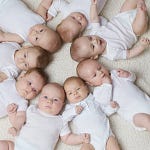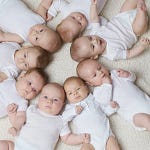During the long dark days of the Covid lockdown, I thought the stars were aligning for a post-Covid baby boom. Working from home made child care much easier, and I believed the trauma of Covid would make more people seek out a family life (being home alone during Covid seemed far worse that spending it with kids, even if you did have to educate them yourself). If that was the social rationale, I also saw a number of technical reasons. First of all, where available, the data seemed to point to at least a stabilisation in the age when women first become mothers. The trend to becoming a mother at ever older ages makes it more and more difficult to have that third child that pushes fertility rates above replacement levels. Using Australian data, mothers born in 1992 seemed to be having babies at the same age as mother born in 1982, while both were having children later than mothers born in 1972. We saw similar trends in Swedish data.
Looking at Medicare (Australian healthcare system data) showed continued growth in IVF cycles. My working assumption is that IVF allows older women to have children, which counteracts the fertility drag of starting families later. That is if the age that women start having babies is not getting older, and IVF treatments are rising, then we should begin to see a reversal in fertility rates.
In 2022, I got very excited that fertility rates were about to go much higher when we saw Danish births spike. However recent data has seen birth rates fall off. Denmark should be one of the first nations to see and ART/IVF led boom, as they have very liberal laws on IVF. Denmark essentially offers ART to any woman under the age of 40.
So signs of a baby boom have been disappointing. But how can we have boom in IVF, but falling births? A recent UK report shows an interesting change in behaviour. First there has been a sharp increase in egg and embryo storage. This is in line with Australian data on IVF treatments.
This has happened despite a share drop in NHS funding of IVF treatments. In particular younger women (18-34) are opting to privately fund IVF cycles.
Why is this? I think there are two factors at play. First of all, it is becoming more widely understood that its not the age of the mother than reduces the likelihood of having a baby, but the age of the egg. The younger the egg, the better chance of having a baby, almost regardless of the mother’s age.
This has led to a births from frozen embryos now being more common that from fresh embryos, even though there are more fresh embryo cycles. This is suggestive of a change in behaviour from mothers. Rather than trying to have a baby, and when that does not work, resorting to IVF, mothers are now being far more forward looking in planning their families.
The baby boom thesis looks intact to me. I believe we are in are in a handover phase with ART. ART was originally seen as an answer to couples with fertility problems. I think ART is now increasingly seen as a technology to empower women and couples to choose when to have healthy babies at the time of their choosing. I think assumptions that Japanese population will fall by half this century will be very far from the mark. And in a big change, birth rates in trich countries will begin to overtake that over poor countries. Better living through technology.















